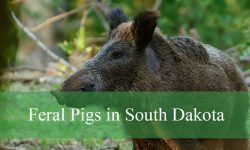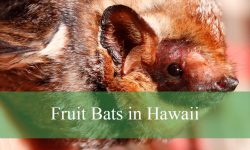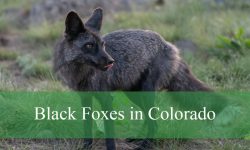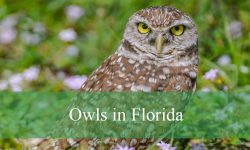Among the forests, parks, and quiet backyards of New Hampshire, a lively variety of squirrels leap, glide, and chatter through the changing seasons. From the common Eastern Gray Squirrel to the elusive Northern Flying Squirrel, these agile creatures are an essential part of the state’s natural balance. Their constant activity adds energy and motion to every corner of the Granite State’s landscapes.
Squirrels in New Hampshire belong to several fascinating groups—tree squirrels, ground squirrels, and flying squirrels—each with its own distinct appearance, behavior, and habitat preferences. Some are bold and vocal, fiercely defending their territories, while others move silently through the canopy under the cover of night. Each species has adapted perfectly to its environment, making them a vital part of the region’s biodiversity.
This article explores 8 types of squirrels found in New Hampshire, featuring detailed identification tips, physical characteristics, habitats, and intriguing behavioral facts. From forest dwellers to suburban visitors, these squirrels reveal the adaptability and charm of New England’s wildlife at its finest.
Types of Squirrels Found in New Hampshire
Eastern Gray Squirrel (Sciurus carolinensis)
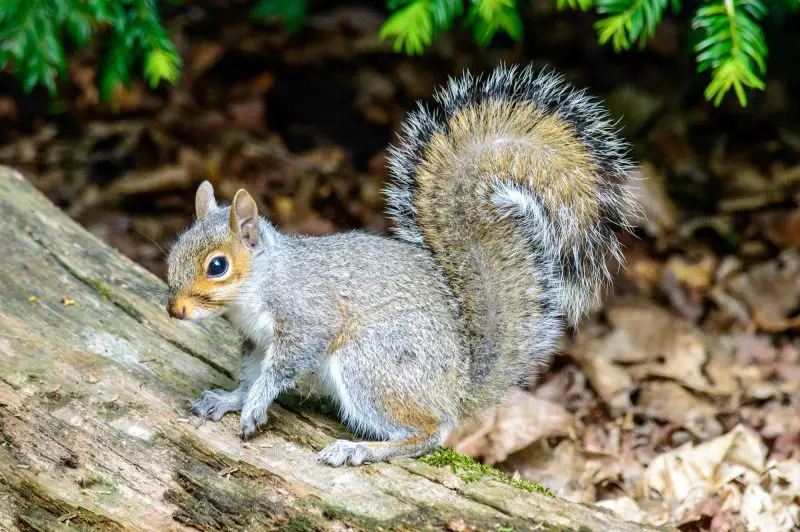
The Eastern Gray Squirrel is one of the most common and recognizable mammals in New Hampshire. These medium-sized tree squirrels have predominantly gray fur with a subtle brownish wash on their backs and a pure white underside. Their bushy tails, often edged with silver, make them look larger than they are. Adults typically weigh between 14 to 21 ounces and measure about 16 to 20 inches from nose to tail tip, making them among the largest tree squirrels in the region.
Identification of the Eastern Gray Squirrel is relatively easy due to its coloration and size. Unlike the smaller red squirrel, it has a softer, grayer coat and a more subdued vocal behavior. Their large dark eyes provide excellent vision for navigating treetops, while their strong hind legs and sharp claws allow them to leap from branch to branch effortlessly. During the colder months, they grow a thicker winter coat for insulation against the snow and wind.
Behaviorally, Eastern Gray Squirrels are highly intelligent and adaptable. They are known for their food-hoarding habits, burying nuts and acorns in numerous locations to sustain themselves through winter. Their remarkable memory and sense of smell help them relocate these caches months later. Although primarily diurnal, they are most active during the morning and late afternoon, avoiding midday heat or intense cold.
In terms of habitat, these squirrels thrive in deciduous and mixed forests, especially where oak, hickory, and maple trees are abundant. They also adapt well to suburban and urban environments, making them a common sight in parks, neighborhoods, and backyards throughout southern and central New Hampshire. They construct leafy nests called dreys in tree forks or occupy tree cavities for better shelter.
A fun fact about Eastern Gray Squirrels is their fascinating communication system. They use tail flicks, chirps, and body postures to signal danger or express dominance. Additionally, despite their name, some individuals have black or even white coats due to genetic variations—a phenomenon that has given rise to small “black squirrel” populations in certain areas of New England.
Red Squirrel (Tamiasciurus hudsonicus)
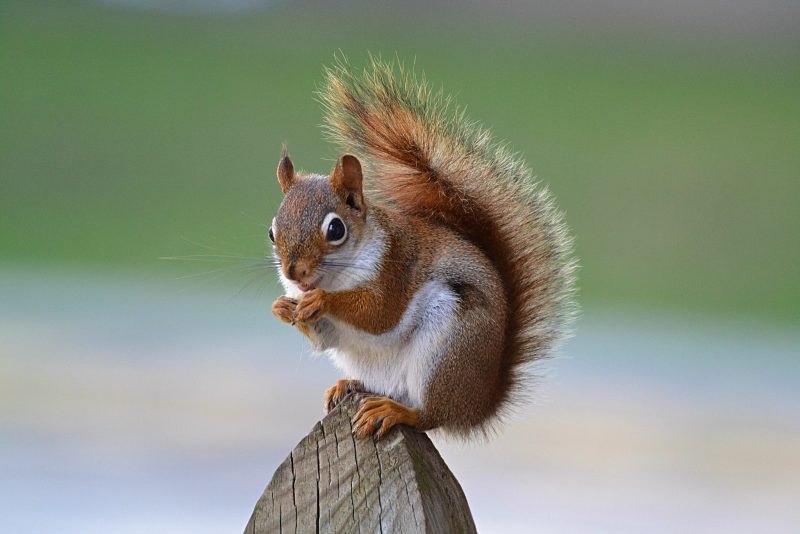
The Red Squirrel, also known as the Pine Squirrel, is a feisty and energetic native of New Hampshire’s coniferous forests. Smaller than the gray squirrel, it is easily identified by its reddish-brown back, white belly, and black lateral stripe in summer, which may fade during winter. Its tail, though bushy, appears slightly less full than that of its gray cousin. Adults usually measure between 11 to 14 inches long and weigh around 7 to 9 ounces.
This species is highly vocal, using rapid trills and sharp chirps to defend its territory. Red Squirrels are notoriously territorial and will chase away intruders, even birds, from their food caches. Their sharp claws and strong hind legs make them agile climbers, capable of darting up and down tree trunks at incredible speed. They are often seen sitting upright, busily stripping cones for seeds—a favorite activity that leaves behind piles of cone scales called “middens.”
Red Squirrels exhibit fascinating behavior, especially when it comes to food storage. Unlike gray squirrels, which scatter-hoard nuts across a wide area, red squirrels create large central caches known as middens. These are often located near logs or under tree roots and can contain thousands of pine cones stored for winter consumption. Their preference for coniferous seeds ties them closely to pine, spruce, and fir forests.
In New Hampshire, Red Squirrels are found statewide, especially in northern and higher-elevation forests. They prefer cooler habitats and are less common in urban settings compared to gray squirrels. They build nests in tree cavities or make compact spherical dreys out of leaves, moss, and bark. During harsh winters, they may remain in their nests for days, venturing out only to retrieve cached food.
A fun fact about the Red Squirrel is its role in shaping forest regeneration. By storing conifer cones and sometimes forgetting them, these squirrels unintentionally aid in the germination of new trees. Their loud chatter and bold attitude have also earned them the nickname “chickaree” among locals, mimicking the rapid sound of their territorial calls.
Northern Flying Squirrel (Glaucomys sabrinus)
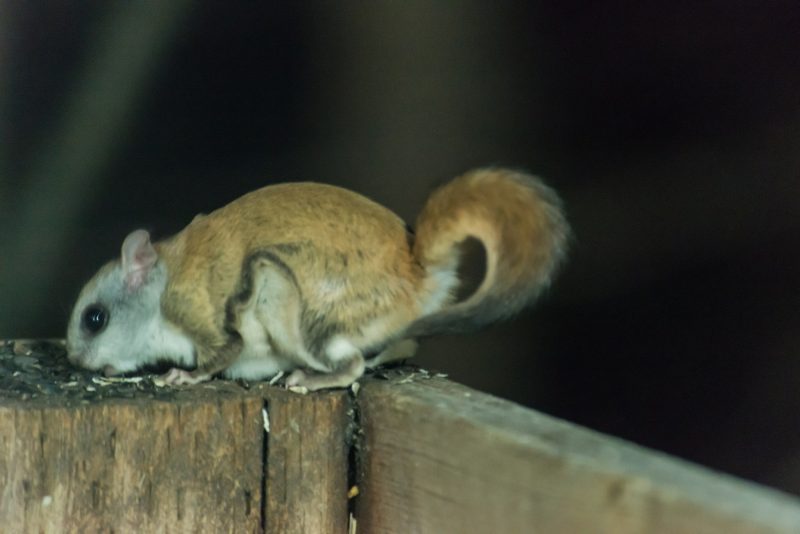
The Northern Flying Squirrel is a nocturnal glider that inhabits New Hampshire’s mature forests. Unlike typical squirrels, it does not truly fly but glides between trees using a membrane of skin called the patagium that stretches from its wrists to its ankles. Its soft, dense fur is grayish-brown on the back and creamy white underneath, with large dark eyes perfectly adapted for night vision. Adults generally measure around 10 to 12 inches long, including their flattened tail, and weigh between 3 to 5 ounces.
Identification of the Northern Flying Squirrel is best done at night when they are active. Their gliding ability allows them to cover distances up to 150 feet in a single leap. Their tails function as rudders, helping control their flight path and stability. Their movements are nearly silent, allowing them to evade predators and move efficiently in search of food. Their round, flattened tail and soft fur distinguish them from smaller Southern Flying Squirrels.
Behaviorally, these squirrels are gentle and social, often sharing nesting sites during winter to conserve warmth. They feed mainly on fungi, lichens, seeds, and nuts, but also consume insects and berries. One fascinating aspect of their diet is their symbiotic relationship with fungi—by consuming and dispersing spores, they contribute significantly to forest health and regeneration.
Northern Flying Squirrels prefer mature coniferous and mixed forests with plenty of old trees and snags that offer nesting cavities. In New Hampshire, they are most commonly found in the northern and higher-elevation regions where spruce and fir dominate. They are rarely seen due to their nocturnal habits, but signs of gliding paths and scat near tree trunks can indicate their presence.
A fun fact about Northern Flying Squirrels is that they glow pink under ultraviolet light—a discovery made by researchers in 2019. This unique biofluorescent trait, visible only under UV, might play a role in communication or camouflage against predators like owls. Their secretive lifestyle and gentle nature make them one of the most intriguing nocturnal mammals in New England.
Southern Flying Squirrel (Glaucomys volans)
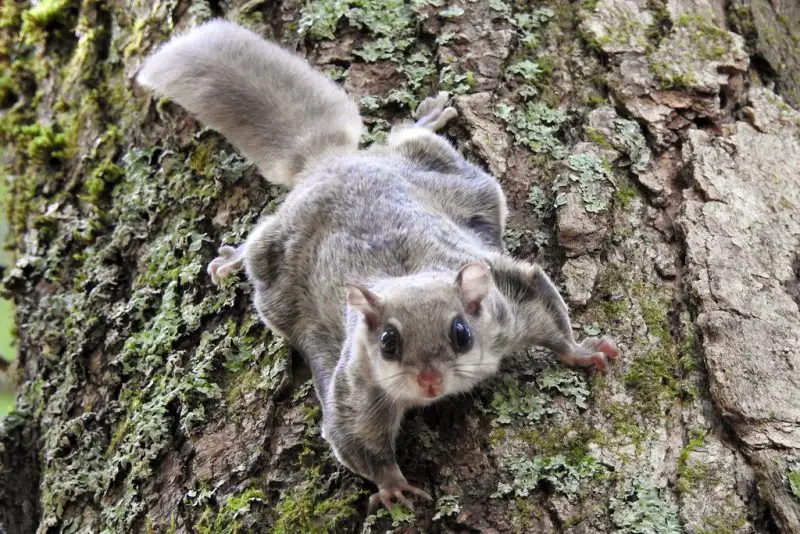
The Southern Flying Squirrel is the smallest of New Hampshire’s native squirrels and is similar in appearance to its northern cousin, though slightly smaller and with softer, more tawny-gray fur. It has large black eyes, a flat tail, and a skin membrane that enables it to glide gracefully between trees. Adults are about 8 to 10 inches long, weighing between 2 to 3 ounces, making them lightweight and perfectly adapted for aerial navigation.
This species is easily mistaken for the Northern Flying Squirrel, but subtle differences help in identification. The Southern variety tends to have a whiter belly and a smaller body overall. It also inhabits slightly warmer, lower-elevation forests. Like its northern relative, it glides silently through the forest canopy, aided by its wide, flattened tail that acts as a stabilizer and brake during landing.
Behaviorally, Southern Flying Squirrels are highly social and often form communal nests during winter months, sometimes with up to 20 individuals sharing the same cavity for warmth. They are omnivorous, feeding on nuts, seeds, insects, bird eggs, and even fungi. Their gliding allows them to forage efficiently while minimizing ground exposure to predators such as owls, snakes, and raccoons.
In New Hampshire, Southern Flying Squirrels are most frequently found in the southern part of the state, where hardwood forests dominate. They favor areas with abundant oak, hickory, and beech trees that provide both shelter and food sources. They nest in tree cavities or abandoned woodpecker holes, often lining them with leaves and moss for insulation during cold weather.
A fun fact about the Southern Flying Squirrel is its remarkable communication ability. These squirrels use high-frequency ultrasonic calls—beyond the range of human hearing—to interact with each other in the dark. Despite their small size, they are extremely agile and can glide up to 200 feet in a single leap, making them the true aerial acrobats of New Hampshire’s forests.
Eastern Chipmunk (Tamias striatus)
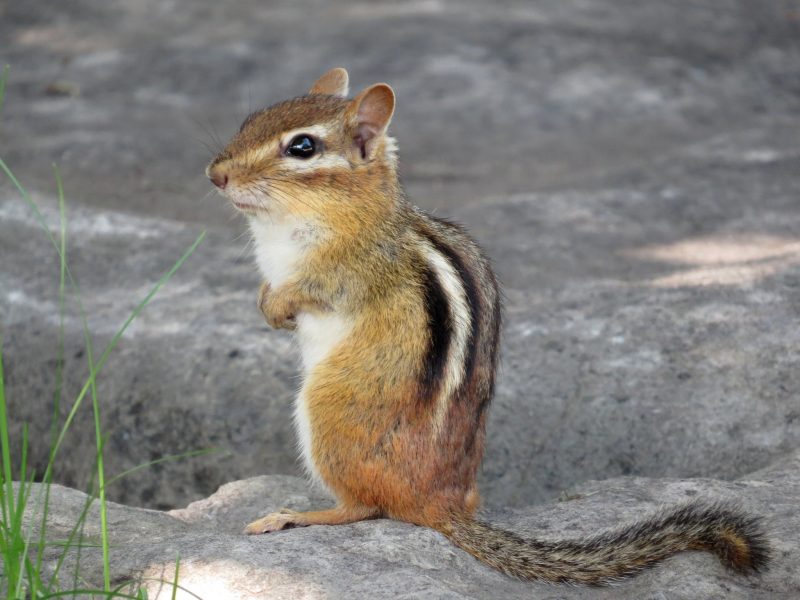
The Eastern Chipmunk is one of New Hampshire’s most familiar and endearing small mammals. Easily recognized by its reddish-brown fur and distinctive dark and light stripes running down its back and sides, this chipmunk is smaller than tree squirrels, typically measuring 8 to 10 inches long including its tail. Its cheeks are expandable, allowing it to carry large amounts of food—such as nuts, seeds, and berries—to store in its burrow. The white belly and small rounded ears give it a charming, alert appearance that makes it a common sight in woodlands and backyards alike.
Identification is quite straightforward due to its striping pattern. The Eastern Chipmunk has five dark stripes and two white stripes on each side, but none on the head, distinguishing it from other chipmunk species found in North America. It is also known for its distinctive “chip-chip” call, which serves as a territorial warning to other chipmunks. Their short tails and quick darting movements make them highly agile both on the ground and in low shrubs.
Behaviorally, chipmunks are solitary and highly territorial. They spend much of their time gathering and storing food in intricate burrow systems that can extend more than 30 feet underground. These burrows contain storage chambers, nesting rooms, and even waste disposal areas. While they do not hibernate fully, they enter a state of torpor during winter, waking periodically to eat from their stockpiles. Their industrious food storage behavior is vital for their survival during long New Hampshire winters.
Eastern Chipmunks inhabit deciduous forests, forest edges, and suburban gardens throughout New Hampshire. They prefer areas with ample ground cover such as logs, rocks, or shrubs for protection from predators. They are equally comfortable near human dwellings, often nesting in stone walls or under decks where they find food and safety. Their adaptability has helped them thrive even as forested land gives way to suburban expansion.
A fun fact about the Eastern Chipmunk is that it plays an important ecological role in seed dispersal. By forgetting some of their buried seeds, they contribute to the growth of new trees and plants, aiding forest regeneration. They are also featured in numerous Native American legends as symbols of energy, curiosity, and resourcefulness.
Woodchuck / Groundhog (Marmota monax)
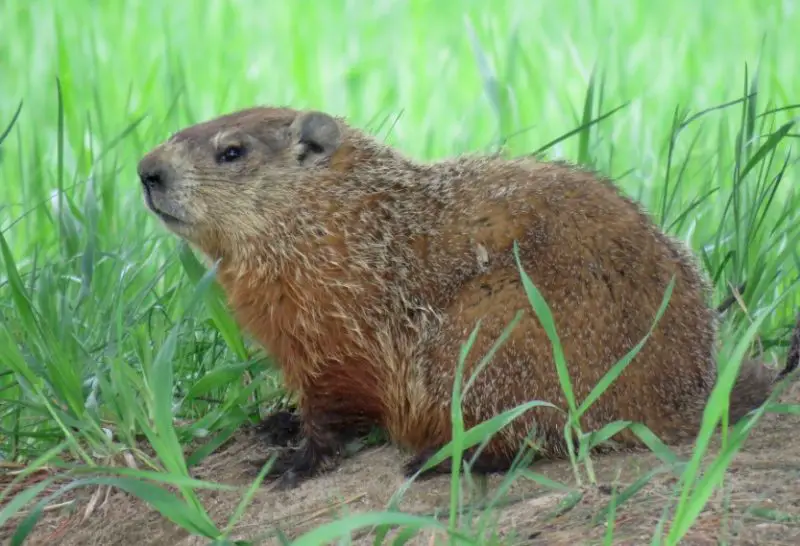
The Woodchuck, also known as the Groundhog, is the largest member of the squirrel family in New Hampshire. These robust rodents can grow up to 26 inches long and weigh between 5 to 12 pounds. Their fur is coarse and brownish-gray, with a short bushy tail and powerful limbs built for digging. Their broad heads and small ears give them a stocky appearance, and they are most often seen grazing in open fields or along woodland edges.
Identification is simple—no other local rodent matches the woodchuck’s size and build. Their incisors grow continuously, requiring constant gnawing on vegetation to keep them trimmed. When alarmed, woodchucks emit a sharp whistle to warn others, earning them the nickname “whistle-pig.” Their large claws and strong shoulders make them expert diggers capable of creating complex burrow systems with multiple entrances and chambers.
Behaviorally, Woodchucks are solitary and diurnal, spending most of their day feeding on grasses, clover, vegetables, and other plants. They are true hibernators, entering deep sleep during the winter months, often from October to March. Their hibernation dens are insulated and safe from freezing temperatures. In summer, they can often be seen basking near burrow entrances, ever alert for predators such as foxes, coyotes, and hawks.
In New Hampshire, Woodchucks are common throughout the state, favoring open meadows, farmlands, and woodland borders. They dig burrows that can extend up to 30 feet long, sometimes causing issues in gardens or pastures. Despite being considered pests by some farmers, they play a crucial role in soil aeration and provide homes for other wildlife once their burrows are abandoned.
A fun fact about the Woodchuck is its association with “Groundhog Day.” According to folklore, if a groundhog emerges from its burrow on February 2 and sees its shadow, it means six more weeks of winter. Though this tradition is more cultural than scientific, it highlights the deep connection between humans and these fascinating creatures.
Thirteen-Lined Ground Squirrel (Ictidomys tridecemlineatus)
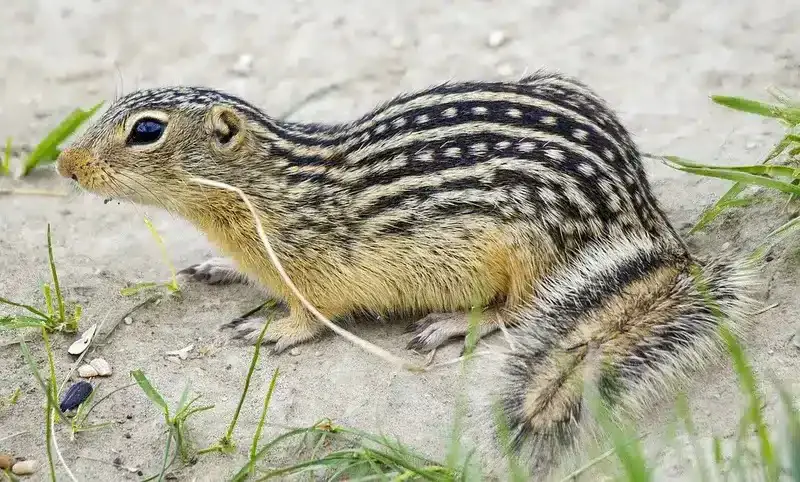
The Thirteen-Lined Ground Squirrel is a rare but intriguing species found mainly in southern New Hampshire. Its name comes from the thirteen alternating brown and whitish stripes that run along its back and sides. These small, slender squirrels measure about 7 to 12 inches in total length and weigh between 6 to 9 ounces. Their short fur and sleek bodies are adapted for life in open grasslands and prairies rather than forests.
Identification of this species is unmistakable due to its striking pattern. The stripes are composed of seven dark and six light lines, some of which are dotted, giving them a unique “spotted stripe” appearance. Their small rounded ears, short tails, and expressive faces make them quite distinct from other squirrels in New England. They are more closely related to ground squirrels of the Midwest, and their presence in New Hampshire is limited to areas with sandy soil and open fields.
Behaviorally, these squirrels are highly alert and spend much of their day standing upright, scanning for danger. They are fast runners and retreat quickly to burrows when threatened. They feed primarily on seeds, grasses, and insects, often storing food underground. During colder months, they enter a true hibernation lasting up to eight months, emerging in spring to breed and forage.
In New Hampshire, Thirteen-Lined Ground Squirrels are rare and mostly restricted to open, sunny habitats in the southernmost regions near the Massachusetts border. They prefer dry, grassy areas such as old fields, golf courses, or pastures. Their distribution is limited because New Hampshire’s heavily forested environment is less suitable for their lifestyle.
A fun fact about this species is that it has been a key model organism in biological research, particularly in studies of hibernation and metabolism. Their ability to lower body temperature and heart rate drastically during hibernation has provided insights into medical applications such as organ preservation and hypothermia therapy.
Fox Squirrel (Sciurus niger)
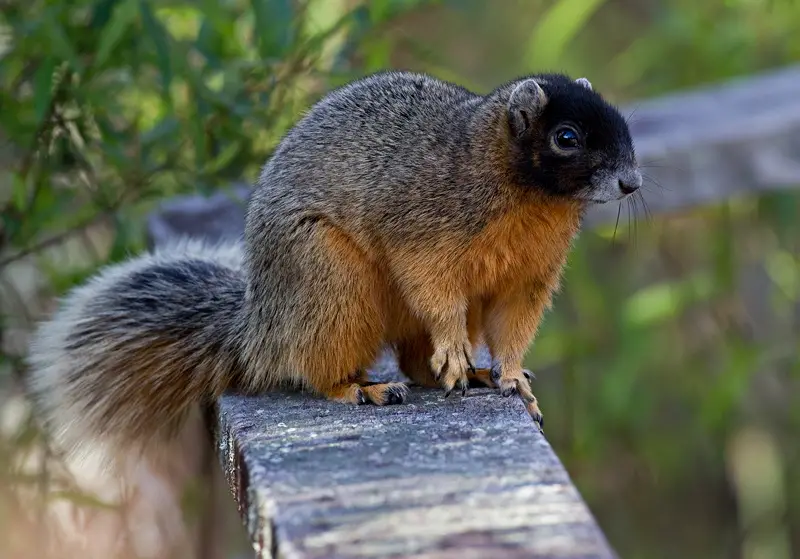
The Fox Squirrel is an uncommon visitor to New Hampshire but can occasionally be found near the state’s southern border. It is the largest tree squirrel species in North America, measuring 18 to 27 inches long and weighing up to 2 pounds. Its fur is typically reddish-gray or orange-brown, with a large, fluffy tail and a rusty underside. Its size and coloration distinguish it from the smaller Eastern Gray Squirrel.
Identification is straightforward due to the Fox Squirrel’s robust build and orange-tinted coat. Some individuals have grayish backs with orange bellies, while others appear nearly golden. Their large claws and muscular hind legs make them powerful climbers, but they are more often seen foraging on the ground than other tree squirrels. Their slow, deliberate movements contrast with the quicker, more agile behavior of gray and red squirrels.
Behaviorally, Fox Squirrels are calm and adaptable. They spend much of their time feeding on acorns, nuts, seeds, and occasionally insects or bird eggs. They are solitary except during mating season or when raising young. Like gray squirrels, they cache food in shallow holes for later consumption. During cold winters, they rely on tree cavities or large leaf nests for shelter.
In New Hampshire, Fox Squirrels are not native but have slowly expanded their range from the Midwest and southern New England. They are primarily found near the Massachusetts border in open woodlands, farmlands, and suburban areas. Their preference for oak-hickory forests aligns well with the southernmost parts of the state, though sightings remain infrequent.
A fun fact about Fox Squirrels is their impressive jumping ability—they can leap distances of up to 15 feet between trees. Despite their name, they have no relation to foxes, though their reddish fur likely inspired the nickname. Their calm demeanor and adaptability make them successful survivors wherever forests meet open fields.
Tips for Observing and Identifying Squirrels in New Hampshire
Spotting and identifying squirrels in New Hampshire can be a rewarding experience for both wildlife enthusiasts and casual nature lovers. With a little patience and a few tricks, you can learn to tell each species apart based on its size, behavior, and habitat.
1. Observe Their Habitat and Location
Different squirrel species prefer specific habitats. Eastern Gray Squirrels and Red Squirrels are most often seen in forests and suburban areas, while Flying Squirrels stick to dense woodlands. Ground dwellers like Chipmunks and Woodchucks favor open fields, stone walls, and garden edges. Knowing where you are helps narrow down which species you’re seeing.
2. Watch for Size and Tail Shape
The Fox Squirrel is the largest, while the Southern Flying Squirrel is the smallest. Gray Squirrels have long, full tails that help them balance when leaping, whereas Red Squirrels’ tails are shorter and thinner. Flying Squirrels’ tails are flat and act as rudders during gliding.
3. Listen to Their Calls
Each species has its own unique sound. Red Squirrels are highly vocal and emit sharp, chattering calls, while Gray Squirrels produce softer “kuk-kuk” or “quaa” noises. Chipmunks are named for their “chip-chip” calls, often heard echoing through wooded backyards. Listening carefully can often confirm identification even before you see them.
4. Look for Food Storage Signs
Squirrels are expert hoarders. Gray Squirrels scatter-hoard nuts across large areas, while Red Squirrels keep centralized piles of pine cones called “middens.” Chipmunks store food underground in complex burrows. Spotting these caches or chewed pine cone piles can reveal which species is nearby.
5. Visit at the Right Time
Most squirrels are diurnal—active during daylight hours—except the Flying Squirrels, which are strictly nocturnal. Early morning or late afternoon are the best times to observe activity, as squirrels are busy gathering food or patrolling their territories. During winter, patience is key, since many species reduce activity or hibernate.
FAQs About Squirrels in New Hampshire
What is the most common squirrel in New Hampshire?
The Eastern Gray Squirrel is the most widespread and commonly seen species across the state. It thrives in both forested and urban environments, adapting well to human presence.
Are flying squirrels really found in New Hampshire?
Yes, both the Northern Flying Squirrel and Southern Flying Squirrel inhabit New Hampshire. The Northern species prefers cooler, coniferous forests, while the Southern is found in the warmer, hardwood regions of the south.
Do squirrels hibernate during winter?
Most tree squirrels, like the Gray and Red Squirrel, do not truly hibernate but remain less active, relying on food caches. Groundhogs and Thirteen-Lined Ground Squirrels, however, enter deep hibernation during the cold months.
What do squirrels eat in New Hampshire?
Squirrels have varied diets depending on species. Common foods include nuts, seeds, fungi, fruit, insects, and buds. Red Squirrels specialize in conifer cones, while Chipmunks and Groundhogs consume a mix of seeds, berries, and vegetation.
Are there any rare squirrel species in New Hampshire?
Yes, the Thirteen-Lined Ground Squirrel is considered rare in New Hampshire, found only in limited southern regions with open, grassy habitats. Fox Squirrels are also uncommon visitors, occasionally seen near the Massachusetts border.
Can squirrels be active at night?
Only Flying Squirrels are nocturnal. All other squirrel species in New Hampshire—Gray, Red, Chipmunk, and Groundhog—are active during the day and rest at night.
Do squirrels damage trees or property?
While squirrels are generally harmless, they can sometimes chew bark, dig in gardens, or seek shelter in attics. Gray Squirrels and Red Squirrels are the most likely culprits. Preventive measures like sealing entry points and securing bird feeders can reduce conflicts.
How can I tell the difference between a Red and Gray Squirrel?
Red Squirrels are smaller, more aggressive, and have reddish coats with white bellies, while Gray Squirrels are larger and have gray fur with a silvery tail. Their vocalizations and preferred habitats also differ—reds favor conifer forests, grays prefer mixed hardwoods.
Why are squirrels important to New Hampshire’s ecosystem?
Squirrels are vital for forest regeneration. By burying seeds and forgetting some of their caches, they help new trees grow. Their burrows also provide shelter for other small animals once abandoned, contributing to overall habitat health.
Can I feed wild squirrels?
Feeding wild squirrels is not recommended. It can make them reliant on humans, alter natural behaviors, and cause aggressive competition. Instead, maintain native trees and shrubs that naturally provide food sources for them year-round.


